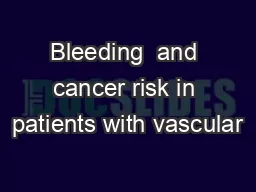

Bleeding and cancer risk in patients with vascular disease COMPASS Steering Committee and Investigators Background Community studies have shown that gastrointestinal GI and genitourinary GU bleeding may be the first sign of underlying cancer ID: 771380
Download Presentation The PPT/PDF document "Bleeding and cancer risk in patients wi..." is the property of its rightful owner. Permission is granted to download and print the materials on this web site for personal, non-commercial use only, and to display it on your personal computer provided you do not modify the materials and that you retain all copyright notices contained in the materials. By downloading content from our website, you accept the terms of this agreement.
Bleeding and cancer risk in patients with vascular disease COMPASS Steering Committee and Investigators
Background Community studies have shown that gastrointestinal (GI) and genitourinary (GU) bleeding may be the first sign of underlying cancer 1,2 The COMPASS trial demonstrated in patients with coronary artery disease (CAD) or peripheral artery disease (PAD) that rivaroxaban-based treatments compared with aspirin increased GI bleeding3It is not known whether GI and GU bleeding also unmasks GI and GU cancers in vascular patients receiving long-term antithrombotic therapy 1. Jones R, et al. BMJ 2007; 334: 1040. 2. Ford AC, et al. Gut 2008; 57; 1545-52. 3. Eikelboom JW, et al. N Engl J Med 2017; 377: 1319-30.
Hypothesis In patients with vascular disease treated with antithrombotic drugs, GI and GU bleeding are associated with increased rates of new GI and GU cancer diagnosis
Methods COMPASS trial randomized 27,395 patients with stable CAD or PAD to receive rivaroxaban 2.5mg bid plus aspirin, rivaroxaban 5mg bid, or aspirin 100mg od Bleeding was defined according to the ISTH criteria (modified) New cancer diagnosis (first-ever cancer, or recurrent cancer in patients with a previous diagnosis in whom the cancer was thought to have been eradicated) was recorded at each follow up visit Bosch J, et al. Can J Cardiol 2017; 33: 1027-1035.
Analyses We examined: The proportion of new cancers diagnosed before and after bleedingThe association between bleeding and new cancer diagnosis (using a stratified Cox proportional hazards model with bleeding modelled as a time-dependent covariate)The rates of cancer diagnosis according to randomized treatment
Number of new cancers and proportion diagnosed before or after bleeding Site Total number of new cancers diagnosed during COMPASS N ew cancers diagnosed after bleeding N % All 1,082* 25723.8% Gastrointestinal 3077022.8% Genitourinary 1386244.9% *Patients could have had more than one new cancer diagnosis
Association between GI bleeding and GI cancer Population Total N New GI cancers (n=307) HR (95% CI) P value N % GI bleeding After bleeding 901*70 7.8 12.9 (9.77-17.0)<0.0001 No prior bleeding 27,3952370.9 Non-GI bleeding After bleeding 1,898*291.51.77 (1.20-2.61)0.004 No prior bleeding 27,3952781.0 *Excludes patients with bleeding who were diagnosed with cancer before the bleeding event
Association between GU bleeding and GU cancer Population Total N New GU cancers diagnoses (n=138) HR (95% CI) P value N % GU bleeding After bleeding 462* 62 13.4 83.4 (58.6-118.6)<0.0001 No prior bleeding 27,395760.3 Non-GU bleeding After bleeding 2,301*140.61.70(0.97-2.99)0.06 No prior bleeding 27,3951240.5 *Excludes patients with bleeding who were diagnosed with cancer before the bleeding event
Timing of cancer diagnosis in relation to bleeding Site of cancer Timing of GI and GU cancer diagnosis Within 6 months of bleed Between 6 and 12 months after bleed More than 12 months after bleed Gastrointestinal 54 (77.1%)6 (8.6%)10 (14.3%)Genitourinary 55 (88.7%)6 (9.7%)1 (1.6%)
Frequency of GI bleeding in year 1, 2, and 3+ according to randomized treatment: landmark analysis Year Rivaroxaban 2.5mg bid + ASA 100 mg od N (%) Rivaroxaban 5mg bid N (%) Aspirin 100mg od N (%) 1 271/9,152 (3.0%)217/9,117 (2.4%)115/9,126 (1.3%)274/7,760 (1.0%)85/7,748 (1.1%)59/7,823 (0.8%)3+35/3,829 (0.9%)29/3,815 (0.8%)30/3,917(0.8%)
Frequency of GI cancer after GI bleeding in year 1, 2 and 3+ Year Rivaroxaban 2.5mg bid + ASA 100 mg odN (%) Rivaroxaban 5mg bid N (%) Aspirin 100mg od N (%) 1 22/268 (8.2%) 18/216 (8.3%)8/114 (7.0%)26/72 (8.3%)6/81 (7.4%)5/58 (8.6%)3+1/34 (2.9%)2/29 (6.9%)2/29(6.9%)
Conclusions Among COMPASS patients with vascular disease on long-term antithrombotic therapy:More than 1 in 5 new diagnoses of cancer are preceded by bleeding GI bleeding and GU bleeding are powerful predictors of new GI and GU cancer diagnosis, respectively, and more than 75% of these cancers are diagnosed within 6 months of the bleedThe early increase in GI bleeding with rivaroxaban-based treatments appears to be associated with earlier diagnosis of GI cancer
Implications The occurrence of GI or GU bleeding in patients receiving antithrombotic drugs should stimulate a vigorous search for cancer in the same organ systemExtended follow-up of COMPASS trial participants may help to determine whether earlier diagnosis of GI cancer in patients with GI bleeding improves cancer outcomes
Acknowledgments COMPASS Steering Committee National Leaders OfficesCOMPASS InvestigatorsCOMPASS Trial Participants Bayer AG
Cancer diagnosis by randomized treatment Cancer R+A(n=9,152) R (n=9,117) A (n=9,126) Total 366 (4.0%) 365 (4.0%) 351 (3.8%) GI 109 (1.2%)111 (1.2%)87 (1.0%) GU47 (0.5%)42 (0.5%)49 (0.5%)GI or GU155 (1.7%)150 (1.6%)136 (1.5%)Non-GI, non GU216 (2.4%)221 (2.4%)218 (2.4%)
Frequency of new GI cancer in year 1, 2, and 3+ post randomization according to randomized treatment YearRivaroxaban 2.5mg bid + ASA 100 mg odN (%) Rivaroxaban 5mg bid N (%) Aspirin 100mg od N (%) 1 52 (0.6%) 52 (0.6%) 38 (0.4%)241 (0.5%)41 (0.5%)30 (0.4%)3+16 (0.4%)18 (0.5%)19 (0.5%)